Your living room serves as the heart of your home and deserves artwork that reflects your personality while creating an inviting atmosphere for family and guests. We’ve discovered that the right art pieces can transform even the most basic space into a stunning focal point that sparks conversation and showcases your unique style.
Whether you’re working with a cozy apartment or a spacious family room we’ll guide you through countless creative possibilities that fit every budget and aesthetic preference. From bold statement pieces that command attention to subtle gallery walls that add sophisticated charm you’ll find inspiration that speaks to your vision.
We’re excited to share our curated collection of living room art ideas that’ll help you create a space that’s both visually striking and deeply personal. Let’s explore how the perfect artwork can elevate your living room from ordinary to extraordinary.
Choose Statement Pieces That Command Attention
Statement art pieces become the focal point that draws every eye in your living room. We recommend selecting artwork that measures at least 36 inches in one dimension to create maximum visual impact.
Large Canvas Paintings
Large canvas paintings transform blank walls into captivating displays that anchor your entire room design. We suggest choosing pieces that measure between 40 to 60 inches wide for optimal visual weight in most living spaces.
Oil paintings offer rich textures and vibrant colors that become conversation starters for guests. Contemporary abstract oils work particularly well above sofas or mantels where they can command attention without overwhelming smaller furniture pieces.
Acrylic canvases provide bold color saturation and modern appeal that complements minimalist or contemporary decor styles. These pieces often feature geometric patterns or sweeping brushstrokes that add movement to static wall spaces.
Mixed media paintings combine various materials like fabric, metal, or wood to create dimensional artwork that changes appearance throughout the day. We find these pieces particularly effective in rooms with varying natural light conditions.
Oversized Photography Prints
Oversized photography prints bring professional gallery aesthetics into your living space while maintaining a sophisticated atmosphere. We recommend choosing prints that measure at least 48 inches wide to achieve proper scale against standard furniture pieces.
Black and white landscapes create dramatic focal points that work with virtually any color scheme in your room. Architectural photography or nature scenes printed on high quality paper become timeless additions that never feel outdated.
Color nature photography featuring forests, seascapes, or mountain ranges brings outdoor tranquility indoors while adding natural color palettes to your decor. These prints work especially well in neutral rooms that need subtle color introduction.
Urban photography captures city skylines, street scenes, or architectural details that add contemporary edge to modern living spaces. We suggest selecting images with strong geometric lines that echo your furniture shapes.
Bold Abstract Artwork
Bold abstract artwork allows you to introduce vibrant colors and ever-changing shapes that energize your living room atmosphere. We recommend selecting pieces with colors that either complement or strategically contrast with your existing palette.
Geometric abstracts feature clean lines and structured compositions that work beautifully in modern or mid century living rooms. These pieces often incorporate primary colors or monochromatic schemes that create visual harmony without being predictable.
Fluid abstracts showcase organic shapes and flowing movements that soften angular furniture lines in contemporary spaces. Paint pours, watercolor effects, or digital abstracts in this style add warmth to minimalist room designs.
Textural abstracts combine raised elements, mixed media, or heavy impasto techniques that create dimensional interest on your walls. We find these pieces particularly effective when positioned where both natural and artificial light can highlight their surface variations throughout the day.
Create Gallery Walls for Maximum Impact
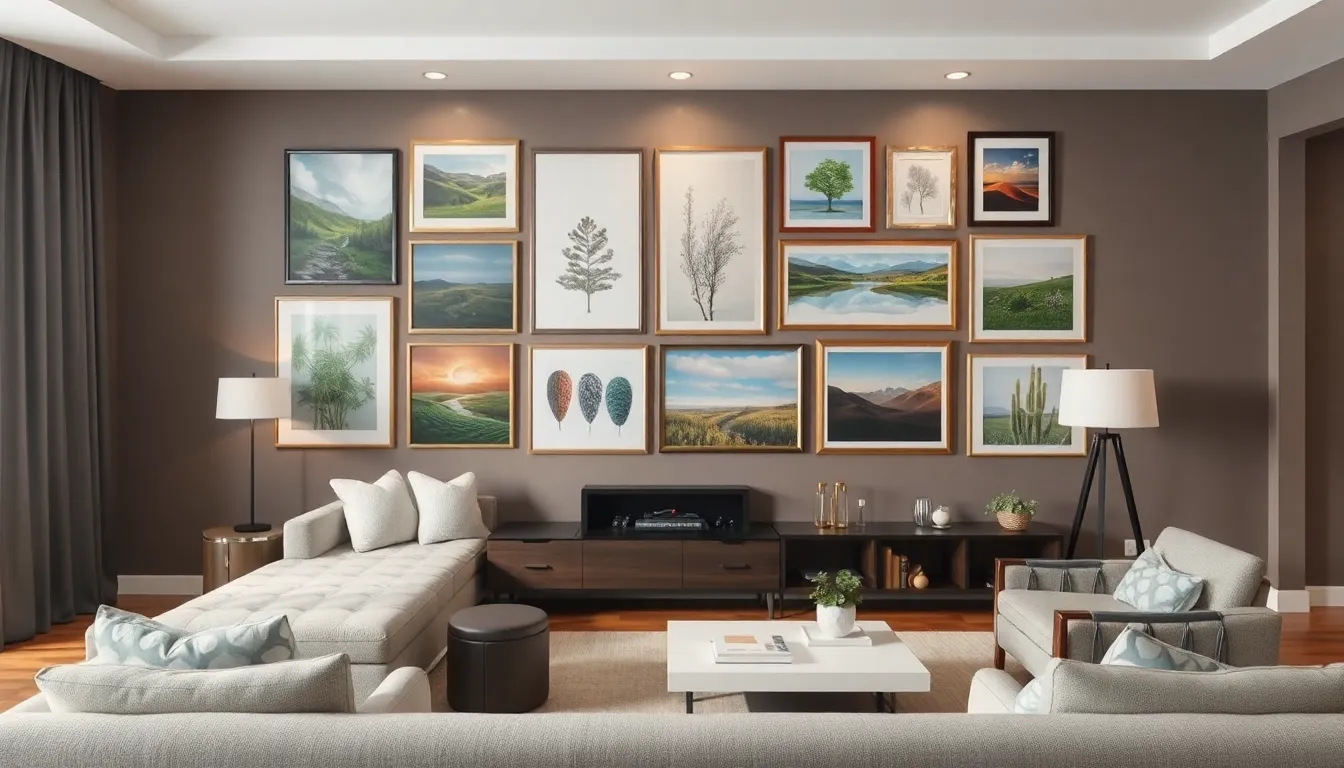
Gallery walls offer the perfect solution for displaying multiple art pieces while creating a cohesive focal point in your living room. We can transform any wall space into a ever-changing visual experience by strategically arranging various artworks together.
Planning Your Layout
Start with a focal point by selecting your largest or most eye-catching piece as the central anchor. We recommend positioning this statement artwork at eye level and building outward from this foundation.
Create sub-groups within your gallery wall to maintain visual balance across the entire display. Group 2-3 smaller pieces together, then connect these clusters through careful spacing and alignment.
Mock it up before committing to nail holes by laying frames on the floor or using digital planning tools. We suggest cutting paper templates matching each frame’s dimensions to test arrangements directly on the wall.
Use floor-to-ceiling designs in larger living rooms to maximize visual impact and create dramatic height. This approach works particularly well when wrapping around furniture pieces like sofas or console tables.
Use corners by extending your gallery wall into adjoining wall spaces, creating an immersive art experience that draws viewers into the room.
Mixing Frame Styles and Sizes
Combine different frame styles including white, black, and natural wood finishes to add depth and visual interest. We find that limiting yourself to 3-4 different frame materials prevents the display from becoming chaotic.
Incorporate various frame sizes ranging from small 8×10 inch pieces to larger 16×20 inch artworks. This size variation creates rhythm and movement within your gallery wall composition.
Experiment with frame thickness by mixing thin contemporary frames with chunkier traditional styles. Varying the frame profiles adds another layer of visual texture to your display.
Balance proportions by ensuring larger frames don’t overwhelm smaller pieces, spacing them appropriately throughout the arrangement.
Balancing Colors and Themes
Select a cohesive color palette that includes 3-5 main colors appearing throughout your art collection. We recommend choosing colors that complement your existing living room decor while adding visual interest.
Ensure theme consistency by focusing on related subjects like nature photography, abstract paintings, or vintage prints. This thematic approach creates unity while allowing for individual piece variation.
Distribute colors evenly across your gallery wall to avoid clustering all similar tones in one area. We suggest stepping back periodically to assess color balance from a viewing distance.
Combine different art themes such as vintage prints with modern paintings or photography with illustrations, maintaining connection through shared colors or similar framing choices.
Incorporate Sculptural Elements for Dimension
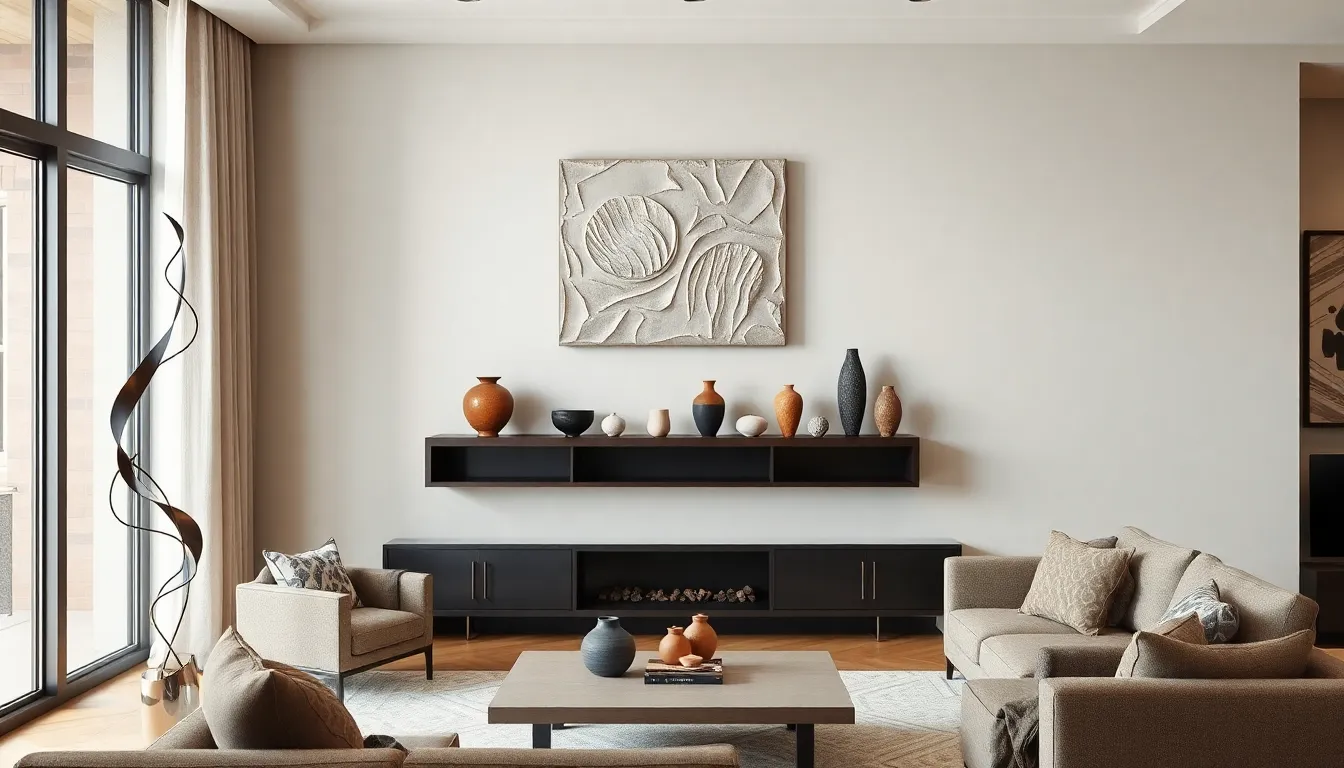
Adding sculptural elements transforms your living room from flat to fabulous by introducing layers of depth and visual intrigue. Three dimensional artwork creates ever-changing focal points that engage viewers from multiple angles.
Floor-Standing Sculptures
Floor-standing sculptures serve as conversation starters that command attention without overwhelming your space. We recommend positioning these pieces in corners or beside seating areas where they can create intimate artistic moments. Metal sculptures offer sleek sophistication, while wooden pieces bring warmth and natural texture to modern living rooms.
Earthy tones and natural textures dominate 2025 design trends, making sculptural pieces with organic elements particularly appealing. Abstract forms work beautifully in contemporary spaces, while figurative sculptures add personality to traditional settings. Consider pieces ranging from 24 to 48 inches in height to maintain proper scale with your furniture.
Wall-Mounted 3D Art
Wall-mounted 3D art eliminates the need for floor space while delivering maximum visual impact. Relief sculptures create stunning shadow play throughout the day as natural light shifts across their surfaces. Mixed media artworks combine textures, colors, and materials to produce gallery worthy displays.
Vibrant maximalism trends in 2025 encourage bold and colorful dimensional pieces that enhance dramatic interior styles. Intricate wood carvings bring artisanal craftsmanship to your walls, while metal reliefs offer industrial chic appeal. Position these pieces at eye level, typically 57 to 60 inches from the floor, to create optimal viewing experiences.
Floating Shelves with Art Objects
Floating shelves transform ordinary wall space into curated gallery displays that showcase your artistic taste. We suggest arranging small sculptures, ceramic vases, and framed prints to create layered compositions. This approach allows you to rotate pieces seasonally while maintaining fresh visual interest.
Curated gallery walls and bold statement pieces remain popular in 2025, making floating shelves versatile answers for both art and decor. Group objects in odd numbers using the rule of three for balanced arrangements. Vary heights and textures across shelves to create rhythm while maintaining cohesive color palettes that complement your room’s overall design scheme.
Select Color-Coordinated Art to Enhance Your Decor
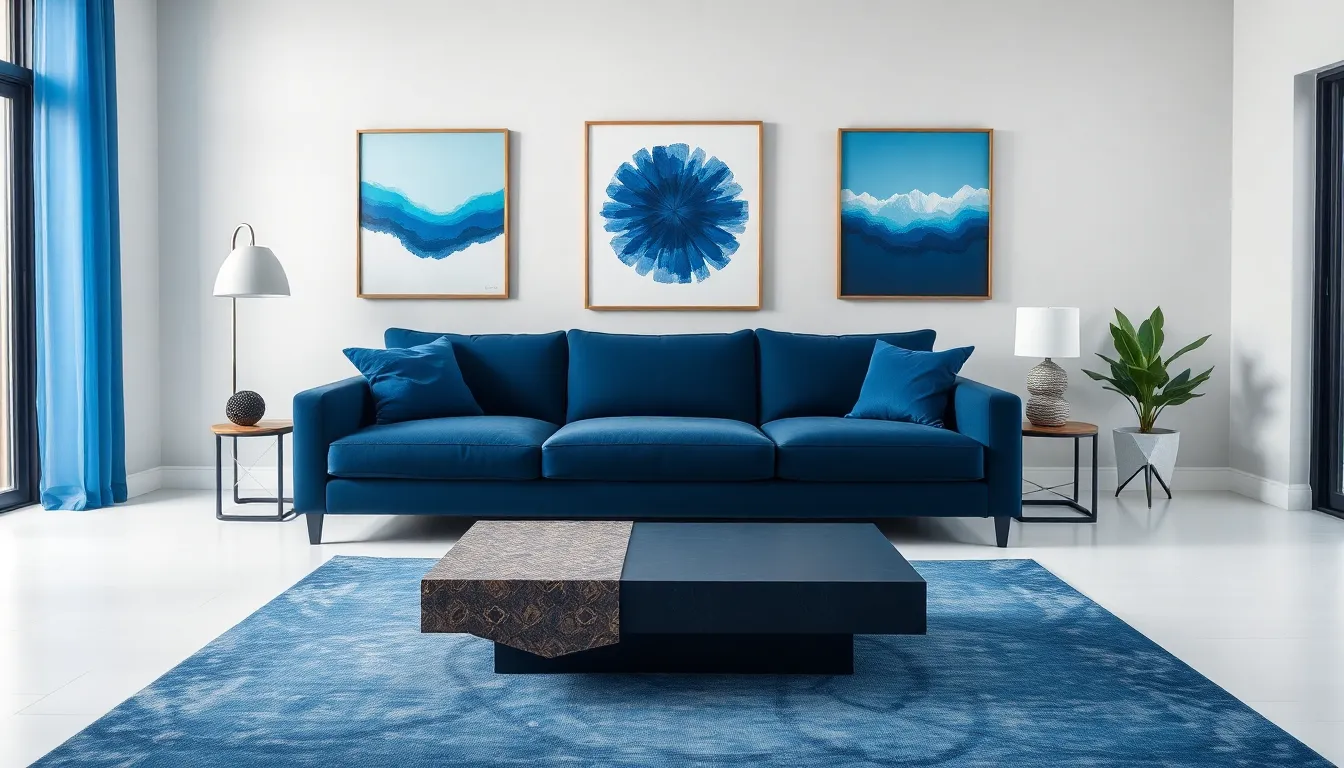
Coordinating artwork with existing room colors creates visual harmony and amplifies your living room’s aesthetic appeal. We’ll explore three proven color coordination strategies that transform ordinary spaces into professionally curated environments.
Monochromatic Color Schemes
Monochromatic schemes use varying shades, tints, and tones of a single color throughout your living room art selection. Navy blue sofas paired with artwork featuring different blue variations create sophisticated and calming effects that work exceptionally well in contemporary settings. Light blue watercolors, deep indigo abstracts, and cerulean industry prints demonstrate how this approach offers subtle visual interest without overwhelming your space.
Contemporary and minimalist living rooms benefit most from monochromatic art coordination because it maintains clean lines while adding depth. We recommend selecting 3-5 pieces in the same color family but different intensities to create layers of visual intrigue. Charcoal gray furniture pairs beautifully with black and white photography, silver metallic prints, and soft gray botanical illustrations.
Complementary Color Combinations
Complementary colors positioned opposite each other on the color wheel create ever-changing and lively atmospheres in living rooms. Blue and orange combinations, green and red pairings, or purple and yellow contrasts draw immediate attention to your artwork while maintaining visual coherence. These opposing hues energize spaces and create modern, vibrant environments that feel intentionally curated.
Orange accent walls showcase blue abstract paintings perfectly, while green botanical prints pop against red brick or burgundy furniture. We suggest using the 60-30-10 rule: 60% dominant room color, 30% complementary artwork colors, and 10% accent details. This balance prevents color clash while maximizing the dramatic impact of your complementary art selections.
Neutral Tones with Pop Accents
Neutral base colors like gray, white, beige, and cream provide versatile foundations for introducing bold accent artwork. Red abstract pieces, mustard yellow photography, or teal geometric prints highlight against neutral backdrops while adding controlled vibrancy to your living space. This combination balances simplicity with eye-catching details that make rooms feel welcoming and stylish.
We recommend starting with 2-3 neutral wall colors and selecting artwork with one consistent accent color repeated throughout different pieces. Cream walls with red accent art, gray furniture with yellow highlight pieces, or white backgrounds with teal focal points create cohesive yet interesting visual narratives. This approach allows seasonal artwork rotations without requiring major decor changes.
Display Personal Photography and Custom Pieces

We transform living spaces into meaningful sanctuaries when we incorporate personal photography and custom artwork. These intimate displays create emotional connections while showcasing our unique stories and experiences.
Family Portrait Collections
Gallery walls featuring family portraits from different eras become captivating conversation starters in our living rooms. We recommend creating a curated display that spans generations, mixing vintage black and white photographs with contemporary color portraits. Professional family sessions, candid moments, and milestone celebrations work beautifully together when arranged thoughtfully.
Themed frames that match the style or era of each portrait maintain visual cohesion throughout the collection. We suggest using antique gold frames for vintage photographs and sleek black frames for modern shots. This approach creates a sophisticated timeline that celebrates our family’s journey while maintaining design harmony.
Framed personal photographs and custom photo collages add warmth and personality to any living space. We find that grouping 5 to 7 family photos in varying sizes creates the perfect balance between impact and intimacy. Consider incorporating baby photos, wedding portraits, and recent family gatherings to tell your complete story.
Travel Photography Displays
Destination focused displays transport us back to cherished memories while inspiring future adventures. We recommend highlighting a exact location by creating a dedicated wall section featuring 3 to 5 photographs from that place. Paris street scenes, Tuscany landscapes, or tropical beach sunsets work exceptionally well as thematic collections.
Mixed media combinations elevate travel photography beyond simple wall hangings. We suggest pairing photographs with vintage maps, collected postcards, or small cultural artifacts from the destination. Shadow boxes measuring 12 to 16 inches allow us to layer these elements effectively.
Travel photography prints sized between 16 to 24 inches create substantial visual impact without overwhelming the space. We prefer canvas prints for landscapes and metallic prints for architectural photography. These formats enhance the immersive quality of our travel memories.
Commissioned Custom Artwork
Local artists create personalized pieces that perfectly complement our home’s aesthetic and our family’s story. We recommend researching artists within a 50 mile radius who specialize in our preferred medium, whether that’s oil painting, watercolor, or digital art. Commission timelines typically range from 4 to 12 weeks depending on the piece’s complexity.
Personalized themes that reflect our experiences, interests, or family milestones result in truly unique artwork. We suggest commissioning pieces that incorporate meaningful elements like our home’s architectural details, beloved pets, or important life events. These custom creations become treasured heirlooms that can’t be replicated.
Hand painted and drawn custom pieces add authentic artistic flair to our living room walls. We find that commissioning portraits of our children, pets, or favorite family locations creates deeply personal focal points. Local art schools often connect us with talented emerging artists who offer competitive pricing for custom work.
Mix Different Art Mediums for Visual Interest
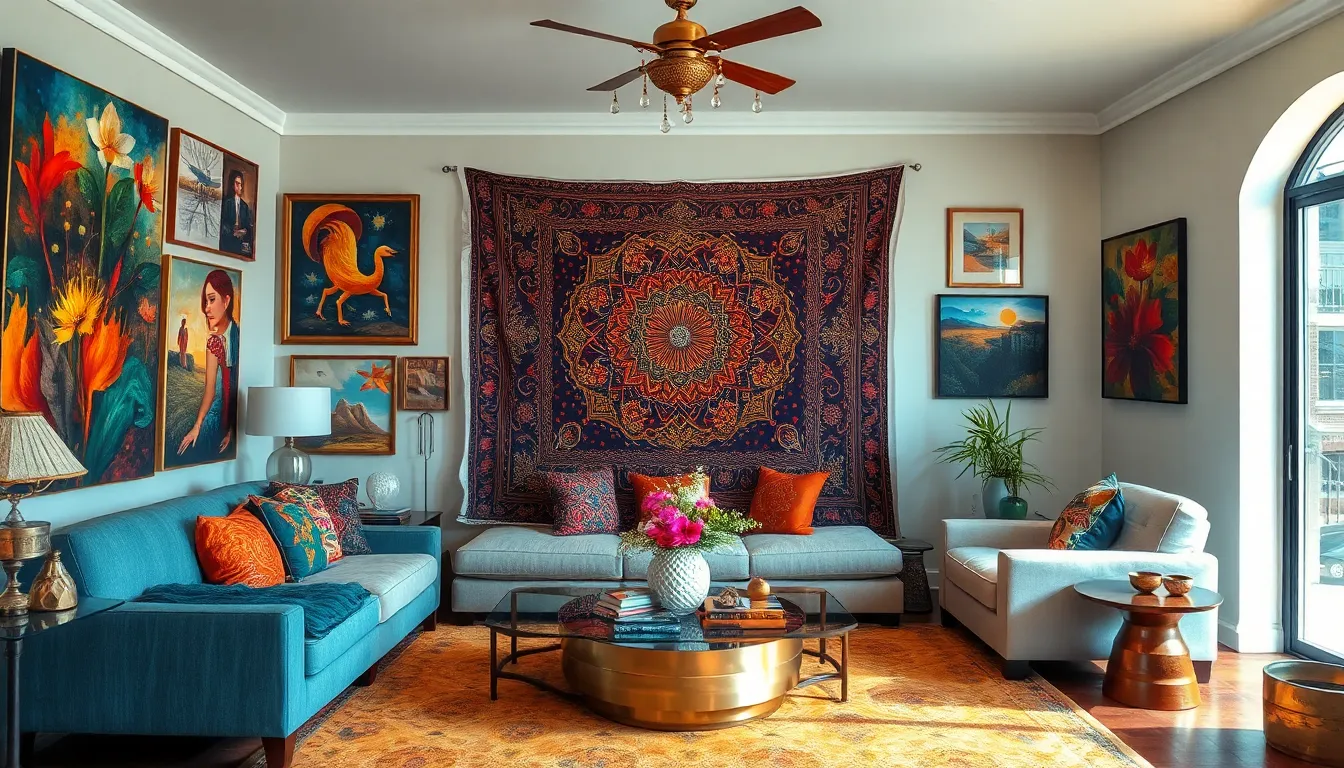
Combining different art mediums creates ever-changing visual layers that transform your living room into a sophisticated gallery space. We’ll explore how strategic mixing of various materials and techniques can add depth and personality to your walls.
Combining Paintings with Prints
Original paintings paired with prints create an eclectic and captivating collage that balances investment pieces with accessible art. We recommend mixing different frame styles to achieve a cohesive yet varied look that adds visual interest without overwhelming the space.
Themed collections work exceptionally well when grouping prints and paintings around exact subjects like nature or cityscapes. This approach creates a cohesive visual narrative while allowing you to incorporate both high-end originals and budget-friendly prints.
Eclectic arrangements benefit from combining various sizes and orientations to maintain visual balance. We suggest anchoring your display with one larger painting and surrounding it with smaller prints in complementary colors or themes.
Adding Textile Art and Tapestries
Tapestry walls serve as stunning focal points that introduce texture and warmth to modern living spaces. Large textile pieces can soften hard surfaces while adding acoustic benefits that paintings and prints cannot provide.
Fabric incorporation extends beyond traditional tapestries to include quilts, embroidered wall hangings, and woven art pieces. These elements bring organic textures that create visual contrast against smooth painted walls or metal fixtures.
Mixed media textile art combines fabric with other materials like paint or found objects to create unique statement pieces. We’ve found that incorporating fabric elements into gallery walls adds tactile interest that invites closer inspection.
Incorporating Metal and Wood Elements
Metal sculptures introduce sleek, modern elements that contrast beautifully with natural wood accents throughout your living room. These pieces reflect light differently than traditional paintings, creating ever-changing shadows and highlights that change throughout the day.
Wooden frames and accents bring warmth and organic texture that complements metal elements while maintaining visual balance. We recommend using wooden frames strategically to bridge the gap between contemporary metal pieces and traditional artwork.
Combined material artwork featuring both metal and wood elements creates sophisticated focal points that work particularly well in transitional design styles. These pieces often incorporate industrial aesthetics while maintaining the comfort that wood elements provide to living spaces.
Consider Lighting to Highlight Your Art Collection

Proper lighting transforms your art display from simply hanging on walls to becoming a captivating focal point. The right illumination brings out colors, textures, and details that might otherwise go unnoticed in your living room collection.
Picture Lighting Answers
Spotlights create dramatic effects that draw immediate attention to exact art pieces in your living room. We recommend installing track lighting systems that allow you to adjust beam angles and intensity for different artwork sizes. Picture lights mounted directly above or below frames provide focused illumination that eliminates shadows and glare.
LED strip lights offer energy efficient options for highlighting multiple pieces along a gallery wall. Position these fixtures at a 30 degree angle from the artwork to minimize reflections on glass or glossy surfaces. Adjustable picture lights with swing arms give you flexibility to redirect light as you rotate or rearrange your art collection.
Wall mounted spotlights work exceptionally well for larger statement pieces that serve as room focal points. Choose fixtures with dimming capabilities so you can control the intensity based on time of day or mood. Battery operated picture lights provide answers for renters or spaces where hardwired options aren’t feasible.
Ambient Lighting Effects
Soft ambient lighting creates a warm and inviting atmosphere that complements your entire art collection. We suggest using floor lamps with fabric shades positioned near seating areas to provide gentle illumination that enhances artwork visibility without creating harsh contrasts. Table lamps on side tables or console surfaces add layers of light that make art pieces more approachable and welcoming.
Pendant lights hung at varying heights create visual interest while casting subtle shadows that add depth to sculptural elements. Consider installing dimmer switches on all ambient lighting fixtures to adjust brightness levels throughout the day. String lights or fairy lights can add a cozy glow behind floating shelves displaying smaller art pieces.
Candles and flameless candles provide intimate lighting options for evening art viewing sessions. Position these light sources strategically to avoid direct heat exposure to valuable artwork while still creating atmospheric effects that enhance your living room’s overall ambiance.
Natural Light Considerations
Natural light sources enhance artwork appearance and create brightness that makes your living room feel more spacious and inviting. We recommend positioning art pieces perpendicular to windows rather than directly opposite to prevent fading from UV exposure. South facing windows provide consistent daylight throughout the day, making them ideal locations for displaying artwork that benefits from natural illumination.
Sheer curtains or blinds help filter harsh sunlight while still allowing enough natural light to showcase your art collection effectively. Consider the changing light patterns throughout the day when planning your gallery wall layout, as morning and afternoon sun create different shadows and highlighting effects.
UV protective glass or acrylic glazing preserves artwork integrity while still allowing you to take advantage of natural lighting benefits. Position mirrors strategically near windows to reflect natural light toward art pieces hung on interior walls, extending the reach of available daylight throughout your living space.
Scale Your Artwork Appropriately for the Space

Selecting the right size artwork transforms your living room from ordinary to extraordinary. We’ll guide you through precise measurements and proportions that create visual harmony between your art and space.
Measuring Wall Proportions
We recommend using the “three eighths” rule when selecting artwork for blank walls. Your art should occupy roughly 57% of the wall’s width to achieve optimal visual balance. For example, a 9-foot (108-inch) wide wall looks best with artwork measuring approximately 60 inches wide.
Wall Width to Art Size Guide:
| Wall Width | Recommended Art Width |
|---|---|
| 6 feet (72″) | 41 inches |
| 8 feet (96″) | 55 inches |
| 10 feet (120″) | 68 inches |
| 12 feet (144″) | 82 inches |
Measure your available wall space with a tape measure before shopping for art. Large spacious rooms with high ceilings benefit from bigger pieces or gallery walls, while smaller living rooms look best with medium-sized artwork or multiple small pieces arranged thoughtfully.
Furniture-to-Art Size Ratios
We suggest choosing artwork that measures 50–75% of your furniture’s width for balanced proportions. If your sofa spans 7 feet (84 inches), select art between 42 and 63 inches wide to create visual harmony.
The “two-thirds rule” offers another reliable guideline for furniture placement. Your artwork should occupy about two-thirds of the furniture width underneath it. This proportion prevents your art from appearing too small or overwhelming the furniture below.
Console tables and credenzas follow similar principles. We recommend artwork that’s slightly narrower than the furniture piece to maintain elegant proportions. Multiple smaller pieces can work together to achieve the desired total width when arranged as a cohesive grouping.
Room Height Considerations
Vertical space requires careful attention to create balanced compositions. We advise leaving 4–6 inches between the bottom of your frame and the top of furniture pieces below. This spacing prevents artwork from appearing cramped while maintaining visual connection.
High ceiling rooms benefit from vertical (portrait) orientation artwork or stacked arrangements. Consider multiple pieces arranged vertically to fill tall wall spaces effectively. The bottom of your art should never hang higher than the top of accompanying furniture.
Standard living room art sizes include small (4×6″–12×18″), medium (16×20″–24×36″), and large (24×36″–40×50″). Always account for frame dimensions when measuring, as frames and mounts add extra inches to your artwork’s overall size before hanging.
Budget-Friendly Art Ideas That Look Expensive
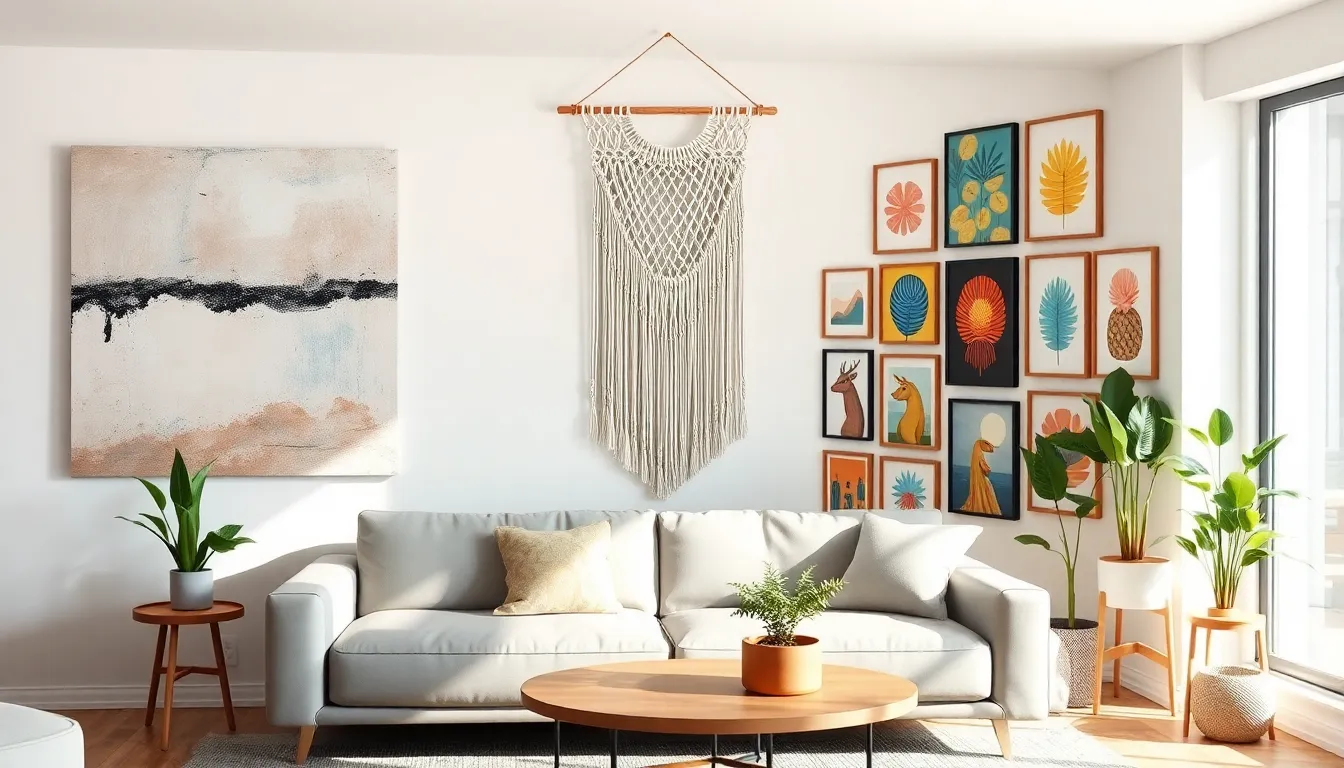
Creating sophisticated artwork for your living room doesn’t require a massive budget when you know the right techniques and resources. We’ll show you how to achieve that high-end gallery look for under $50 per piece.
DIY Canvas Projects
Painted canvas art transforms blank walls into stunning focal points using simple techniques that rival expensive originals. Abstract designs work exceptionally well for beginners since they’re forgiving and allow creative freedom with color combinations. Nature-inspired themes like botanical silhouettes or industry gradients create sophisticated pieces that complement neutral décor schemes.
Macrame wall hangings bring bohemian elegance to your living space with just basic rope and online tutorials. These textural pieces add dimensional interest and work particularly well above sofas or in corner arrangements. You can customize the size and pattern complexity based on your skill level and available wall space.
Textured canvas techniques using household items create expensive-looking artwork for under $30. Mix sand or modeling paste with acrylic paint to achieve gallery-worthy texture effects. Layer different colors while the base is still wet to create organic blending that mimics professional techniques.
Printable Art Downloads
Free and affordable printable art downloads offer instant access to professional designs that you can customize for your space. Websites provide thousands of options ranging from minimalist line drawings to vibrant botanical prints. Print these on high-quality paper or canvas using your home printer or local print shop for professional results.
Customizable art platforms let you upload personal photos and transform them into printable masterpieces. Convert your travel photos into black and white architectural prints or create abstract color manipulations from nature shots. These personalized pieces become conversation starters while maintaining that expensive custom art appearance.
Gallery wall combinations using multiple printable pieces create impressive displays for less than $20 total. Mix different frame styles and sizes to add visual depth and professional polish. Choose prints with complementary color schemes to maintain cohesion while maximizing impact across your wall space.
Thrift Store Finds and Upcycling
Secondhand art pieces from thrift stores offer unique vintage character that you can’t find in mass-produced options. Look for artwork with interesting subjects or unusual frames that can be refreshed with new matting or paint. Even damaged pieces can become stunning focal points with creative restoration techniques.
Upcycled frames transform ordinary prints into expensive-looking gallery pieces through strategic refinishing. Sand and repaint thrifted frames in trendy colors like matte black or brushed gold to match your décor. Replace cheap matting with museum-quality mat board to instantly elevate the perceived value of any artwork.
Vintage book pages and sheet music create sophisticated collages when properly mounted and framed. Layer these ephemeral materials behind glass with professional spacing to achieve that curated antique look. Group multiple pieces together for a scholarly aesthetic that suggests expensive rare book collections.
Seasonal Art Rotation to Keep Things Fresh
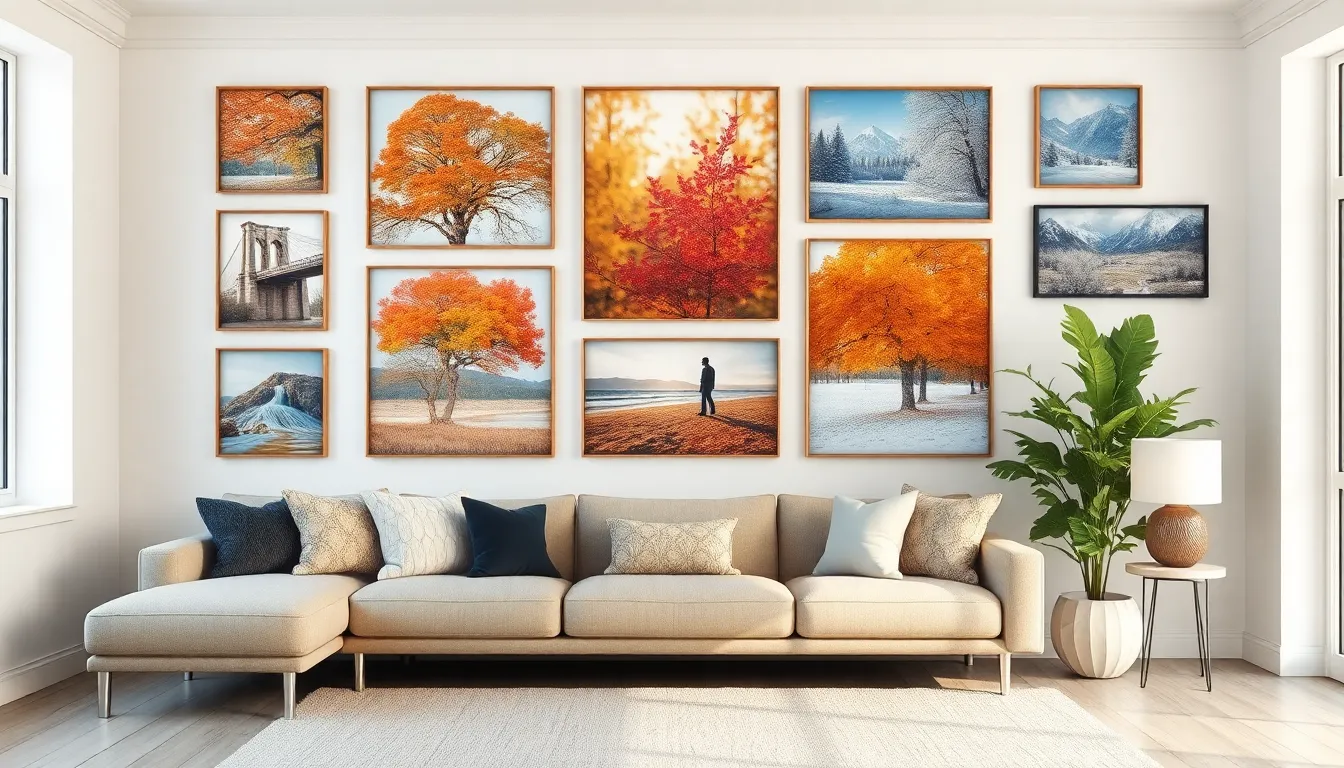
We can transform our living rooms throughout the year by rotating artwork seasonally. Fresh displays keep our spaces ever-changing and prevent visual stagnation while reflecting the changing seasons and our evolving tastes.
Creating Interchangeable Displays
Gallery walls offer the perfect foundation for seasonal art rotations because they accommodate multiple pieces that we can easily swap out. We recommend designing flexible layouts using floating shelves that allow us to rearrange or replace artwork without damaging walls. Magnetic frame systems make switching artwork effortless, letting us change displays in minutes rather than hours.
Grid systems work exceptionally well for interchangeable displays since they provide consistent spacing while offering flexibility. We can create themed groupings within our gallery walls, dedicating exact sections to seasonal pieces that rotate every three to four months. Picture ledges present another versatile option, enabling us to layer artwork and create depth while maintaining the ability to make quick seasonal updates.
Storage Answers for Artwork
Art storage boxes designed specifically for protecting artwork keep our rotating pieces safe when they’re not displayed. We should invest in archival quality storage materials that prevent moisture damage and UV deterioration. Acid free tissue paper and protective sleeves ensure our artwork maintains its quality during storage periods.
Hanging storage racks installed in closets or basements maximize vertical space while keeping larger pieces organized and accessible. Portfolio cases work perfectly for prints and smaller canvases, allowing us to categorize artwork by season or theme. Climate controlled storage areas protect our investment pieces from temperature fluctuations that could cause warping or cracking.
Digital cataloging systems help us track our rotating collection, enabling us to plan seasonal displays months in advance. We can photograph each piece and create seasonal mood boards that guide our rotation decisions throughout the year.
Holiday and Seasonal Themes
Themed artwork celebrates exact holidays and seasons while maintaining our living room’s overall aesthetic cohesion. Christmas prints featuring elegant winter landscapes complement traditional holiday decor without overwhelming the space. Halloween decorations in sophisticated black and gold tones add seasonal flair while preserving our room’s mature design sensibility.
Seasonal color palettes guide our artwork rotation, with warm autumn tones transitioning to cool winter hues and eventually bright spring pastels. We can incorporate summer themed pieces featuring vibrant blues and greens that reflect the energy of warmer months. Nature inspired artwork works particularly well for seasonal rotations since it naturally aligns with changing outdoor landscapes.
Holiday exact artwork doesn’t need to be explicitly festive to enhance seasonal decor. Abstract pieces in seasonal colors create subtle thematic connections while maintaining year round appeal. We can also rotate photography collections, featuring winter cityscapes during colder months and beach scenes during summer, creating immersive seasonal experiences in our living spaces.
Conclusion
Your living room’s artistic transformation awaits with these carefully curated ideas that blend style function and personal expression. We’ve shown you how to create stunning displays that reflect your unique personality while maintaining visual harmony throughout your space.
From statement pieces to budget-friendly DIY projects every approach we’ve discussed offers opportunities to elevate your home’s aesthetic. Whether you’re drawn to gallery walls sculptural elements or seasonal rotations the key lies in choosing pieces that resonate with your lifestyle and design vision.
Start with one focal point and build from there. Your living room can become an inspiring gallery that tells your story welcomes guests and brings daily joy to your home experience.
Frequently Asked Questions
What size artwork should I choose for my living room wall?
For optimal visual impact, use the “three-eighths” rule where artwork should occupy roughly 57% of your wall’s width. Statement pieces should measure at least 36 inches in one dimension, with large canvas paintings ideally between 40-60 inches wide. For furniture placement, artwork should be 50-75% of your furniture’s width for balanced proportions.
How do I create a cohesive gallery wall in my living room?
Start with a central anchor piece and build outward using sub-groups for visual balance. Create mock-ups with paper templates before hanging. Mix frame styles and sizes while maintaining consistent spacing. Balance colors and themes throughout the display, and consider floor-to-ceiling designs for larger spaces to create an immersive art experience.
What are some budget-friendly living room art ideas?
Try DIY canvas projects with abstract designs or nature themes for under $50. Download printable art for instant, customizable options. Explore thrift stores for vintage pieces that can be upcycled. Create macrame wall hangings for bohemian elegance, or use textured canvas techniques with household items for gallery-worthy effects under $30.
How should I light my living room artwork?
Use track lighting, picture lights, or LED strip lights to enhance visibility while minimizing glare. Add ambient lighting with floor and table lamps for warmth. Position artwork strategically to avoid UV damage from natural light. Use sheer curtains and mirrors to optimize natural illumination and create dynamic lighting effects.
What color schemes work best for living room art?
Choose from three main strategies: monochromatic schemes using varying shades of one color for sophistication, complementary colors with contrasting hues for energy, or neutral tones with bold pop accents for versatility. Each approach maintains visual harmony while allowing personal expression and easy seasonal updates.
Should I mix different art mediums in my living room?
Yes, mixing mediums creates visual interest and depth. Combine original paintings with prints for an eclectic look. Add textile art and tapestries for texture and warmth. Incorporate metal sculptures for modern contrast with wood accents. Use themed collections around subjects like nature or cityscapes for cohesive visual narratives.
How can I incorporate personal touches into my living room art?
Create gallery walls featuring family portraits from different eras, mixing vintage and contemporary styles. Display travel photography with thematic collections and mixed media elements. Commission custom artwork from local artists for unique storytelling pieces. Use themed frames to maintain visual cohesion while showcasing personal memories and experiences.
What are sculptural elements and how do I use them?
Sculptural elements add dimension beyond flat wall art. Use floor-standing sculptures as conversation starters in materials like metal for sophistication or wood for warmth. Try wall-mounted 3D art for shadow play effects. Display small sculptures on floating shelves for seasonal rotations and curated arrangements.
How often should I rotate my living room artwork?
Consider seasonal rotations to keep your space fresh and reflective of evolving tastes. Use flexible gallery wall layouts with floating shelves and magnetic frame systems for easy swaps. Store unused pieces in archival quality boxes or hanging racks. Incorporate themed artwork for holidays and seasons with appropriate color palettes.
What’s the proper spacing between artwork and furniture?
Hang artwork 6-8 inches above furniture for optimal visual connection. Maintain consistent spacing between multiple pieces (typically 2-4 inches apart). Consider vertical space and ceiling height when determining placement. Ensure artwork doesn’t overwhelm smaller furniture pieces by following the 50-75% width ratio guideline for balanced proportions.







